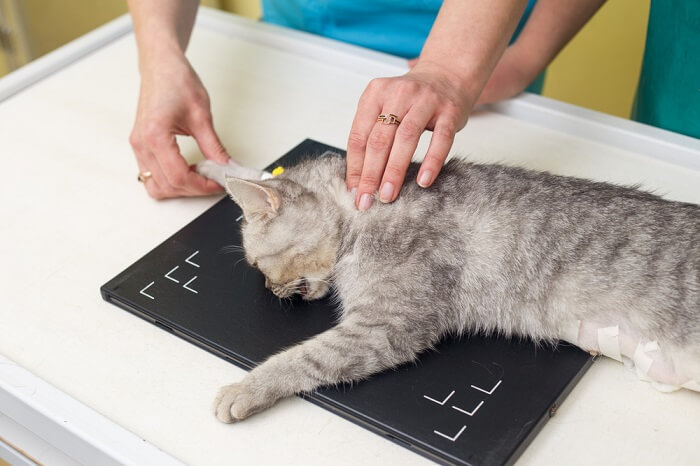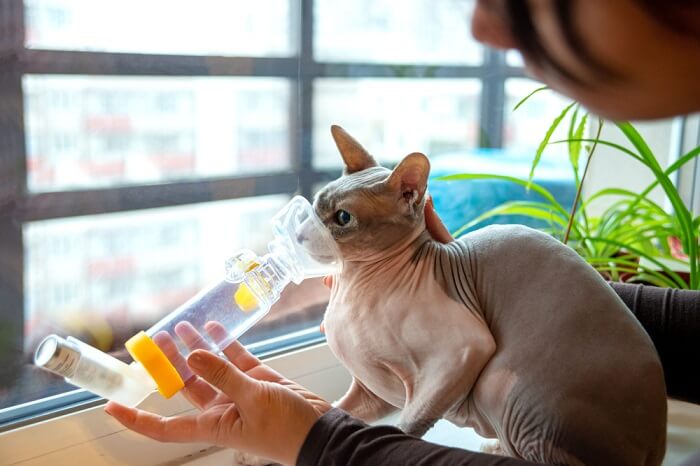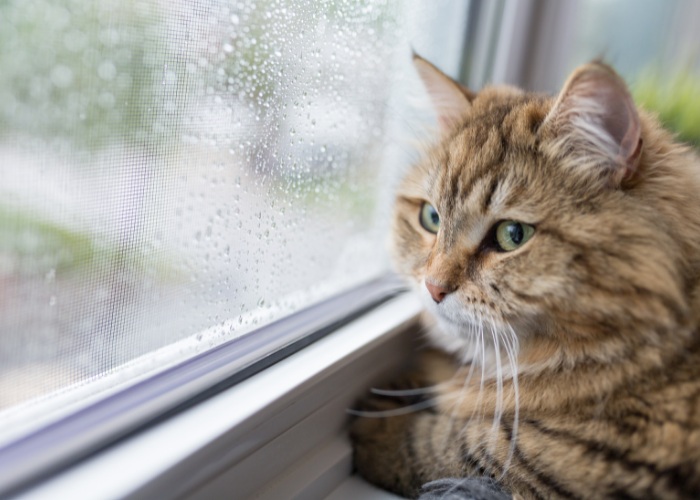
This article aims to explain the details of bronchitis, a respiratory condition that can happen in cats for a number of reasons. The aim of this article is to provide a simple, clear explanation of bronchitis for cat owners.
Quick Overview: Cat Bronchitis (Feline Asthma)







What Is Bronchitis?
Bronchitis is defined as inflammation of the bronchi and bronchioles, which are the smaller tubular airways that branch out into the lungs from the main airway, which is called the windpipe or trachea.
This is an airway disease that can cause coughing and respiratory distress. Feline bronchitis describes a group of common inflammatory airway diseases of cats that include feline asthma.
The inflammation of the bronchi causes the walls of the airways to become thickened and swollen, along with excessive mucus production, with secretions gathering in the airways. It’s a useful comparison to think about how nasal secretions gather when you have a cold, and you can remove these by blowing your nose.
When similar secretions gather in the airways, deep inside the lungs, it’s difficult to clear these away, and that’s why the signs of bronchitis are seen. Constriction (narrowing) of the airways can also happen due to an allergic reaction, and this aggravates the signs of bronchial disease.
How Common Is Bronchitis?
It’s estimated that around 1% of cats are affected by bronchitis, and there is a higher prevalence in Siamese cats (around 5%).
Symptoms of Bronchitis in Cats
Clinical signs include the following:
- Respiratory distress
- Rapid breathing (tachypnea)
- Difficulty breathing (dyspnea)
- Open-mouth breathing
- Coughing (some owners mistakenly believe that their pet may have hairballs)
- Noisy breathing, such as wheezing or even a rattling sound
- Systemic signs such as inappetence, weight loss, and dullness may be seen
Causes of Bronchitis in Cats
Bronchitis can be caused by a number of different factors, while asthma (sometimes called bronchial asthma or allergic bronchitis) is a specific allergic reaction to airborne particles.
There are four main groups of causes:
- Allergic reaction (causing so-called feline asthma). There are many possible allergens, including dust, house dust mites, molds or fungal spores, and pollens.
- Inhalation of irritants, such as chemicals, household sprays (including hairspray), and tobacco smoke.
- Infectious causes, including viruses, bacteria, and parasites (lungworm or heartworm disease).
- Immune-mediated disease.
Diagnosis of Bronchitis

To determine if your cat is suffering from bronchitis, your veterinarian may follow a series of steps, including history-taking, physical examination, and more.
If your DVM veterinarian suspects that your cat may have bronchitis, the following steps may be taken.
1. Detailed History Taking
Your vet will discuss every aspect of your cat’s life and health care. There are other reasons why cats can develop similar signs as bronchitis (such as heart failure and other types of lung disease), and this history will help to differentiate the various possible causes.
This will include asking questions about possible exposure to airway allergens or irritants (e.g. the use of aerosol sprays in the cat’s vicinity).
2. Physical Examination
Your veterinarian will check your cat over carefully, noting any physical signs of illness, ruling out other causes of the signs that are being shown (e.g. heart disease, poisoning, etc). Your vet will listen to your cat’s chest with a stethoscope as part of this examination.
3. Routine Blood Tests
Your veterinarian may suggest blood tests, including the usual panel of diagnostic tests, such as hematology (blood count) and biochemistry profiles, to confirm that there is no other underlying cause making your cat ill.
4. Diagnostic Imaging
Radiographs (chest x-rays) may be taken to visualise the internal structures in your cat’s chest, including the windpipe, lungs, and heart. If bronchitis or asthma is present, a particular pattern of changes may be seen, caused by the thickening of the walls of small airways and the accumulation of secretions. However, importantly, up to 40% of cases may have few, or no, changes on x-rays.
5. Bronchoalveolar Lavage
Under general anesthesia, a sample of fluid and cells can be collected from the lungs using a technique known as bronchoalveolar lavage. This sample can be sent off to the laboratory for cytology (examining the type of cells present) and culture (incubating the sample to discover which bacteria are present as well as the most effective antibiotics to use to treat them).
Specific white blood cells (eosinophils) indicate an allergic-type reaction, and lungworms, or eggs, may be identified if these are present.
6. Other Tests
Other diagnostic tests may include heartworm tests, fecal floatation (to check for lungworm), and echocardiography (ultrasound to check the heart function).
How Much Does It Cost To Treat a Cat With Bronchitis?
It is impossible to estimate this cost, as there are so many possible factors going on in the background of individual cases.
You should ask your veterinarian for a detailed estimate before agreeing to proceed with treatment. As examples, an initial workup could cost $300 to $1000, and ongoing treatment might cost $60 to $150 per month.
Treatment for Bronchitis

Bronchitis in cats may be treated with a variety of solutions, including bronchodilators, medications, and environmental modification.
There are three main ways that cats are treated for bronchitis:
1. Environmental Modification
If a primary cause of irritant or allergic bronchitis can be identified, this should be removed e.g. tobacco smoke, cooking fumes in the kitchen, specific cleaners, or aerosol sprays.
2. Bronchodilators
Bronchodilators are drugs that widen the small airways. Examples include terbutaline, which can be given orally or by injection, and albuterol, which is usually given via an inhaler via a facemask. These medications tend to be used to treat episodes, based on clinical signs, rather than to prevent bronchitis
3. Anti-Inflammatory Medication
To prevent and control airway inflammation, it’s logical to use anti-inflammatory medication, and this is usually how the chronic inflammation of this condition is kept under control.
Corticosteroids, and in particular oral prednisolone, is the most common medication to be used, with the lowest effective dose being determined for ongoing use. Injectable long-acting formulations of corticosteroids (an injection every 4 – 8 weeks) can be a practical answer for some situations, but side effects are more likely if this method is used.
Topical steroids, supplied via a spray and facemask, are a helpful way of reducing side effects, as the medication acts locally in the lungs rather than systemically. Fluticasone propionate.
Cyclosporine is an alternative anti-inflammatory drug that may be used in cases where corticosteroids are problematic (eg cats with diabetes mellitus).
Adipose-derived mesenchymal stem cell therapy is the latest possible therapy to be investigated, but it is not yet widely available.
Monitoring and Prognosis
The airway inflammation in bronchitis is generally reversible, and most cats with bronchitis can be maintained through regular medication with intermittent veterinary examinations to ensure that the problem is properly controlled. The prognosis is good for most affected cats, with a normal life span expected.
Conclusion

Many cats with bronchitis require ongoing treatment to lead happy, healthy lives after diagnosis.
Bronchitis, including feline asthma, is a common airway disease in cats, leading to coughing, difficulty breathing, and rapid breathing. Ongoing treatment is often needed to ensure that this condition is kept under control in affected individuals.








My 10-year-old Siamese cat coughs a few times a week. He has had bloodwork and lung x-rays, and everything is normal. He has been given antibiotic shots which relieve his coughing for 3-6 weeks, but then it returns. Any help would be appreciated.
I think that a detailed discussion with your vet may help here. From what you say, it sounds like there could be some sort of infection going on (the antibiotics then temporarily fix this) but I would be suspicious that perhaps the vet is also giving a depot steroid injection – this usually lasts 3 – 4 weeks, and it will have an anti-inflammatory effect that would stop asthma, if asthma was present. You see, with asthma, it’s common for blood work to be normal, and in some cases, any changes on xray are also minimal. You would need to do extra tests (such as bronchoalveolar lavage) to confirm the diagnosis, and many vets instead simply give treatment for asthma (such as the long acting depot steroid injection). So double check with your vet about precisely what they are giving your cat (get the brand name, dose etc) and then please get back to me with that info. Thanks.
my ginger tabby has asthma and coughs about four times a week. he is also sneezing nonstop at night.